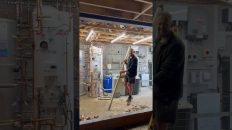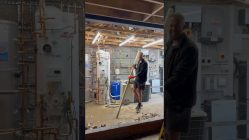#NGCFE #Plumber Historically, heating controls have been antiquated on/off type programmers and thermostats. While this has served the heating industry well as they are simple to understand and install, they have led to significant efficiency and comfort issues that needed to be addressed by the industry.
The problem with basic on/off controls is that the control they have over the heat source (outside of switching it on and off) is non-existent. What this meant was that boilers would operate at maximum output and chuck masses of heat around the radiators which would transfer heat to the rooms until the room thermostat switched off the boiler when the room achieved its target temperature. The issue here is that the temperature of the radiators / system would continue transferring the heat to the room until the radiators cooled down. This excess heat being transferred into the room would result in the room getting hotter than desired, usually by a couple of degrees. The same situation would apply to the room undershooting the room temperature as the room began to cool down and the heating control would not turn the boiler on until the set temperature was lost. The boiler would turn back on, but there would be a delay in getting the radiators hot enough to heat the room adequately again. This again may be a couple of degrees below the room set temperature.
This process of the room fluctuating in temperature and the boiler constantly turning on and off is known as cycling. Cycling really isn’t great for heating systems and can reduce the life expectancy of the heat source. It can also lead to increased maintenance costs due to components becoming worn quicker. Not to mention a reduction in comfort for customers.
Opentherm is a protocol developed by Honeywell a while back whereby heating manufacturer’s products can all communicate using the same ‘language’. The idea is that if we can get appliances and controls to constantly communicate with each other then we can achieve a much more efficient system. We can do this by utilising technology like load compensation and weather compensation.
Load compensation is a process whereby the control monitors the difference between the actual room temperature and the room set temperature and tells the boiler to give more or less heat depending on how much further the room needs to be heated. The result is that a well-designed load compensation system will ensure that the boiler operates at a lower output for longer periods of time. While this is more efficient in the majority of cases, its also much gentler on the boiler components as there is far less cycling.
Weather compensation is another process whereby the boilers output is controlled by external controls. In the case of weather compensation, The output of the boiler is controlled by an NTC sensor on the outside of the property (ideally on a north facing wall). Depending on the temperature of the outside atmosphere, the boiler will adjust its flow temperature to put either more or less heat energy into the property. While the temperature of the radiators will fluctuate depending on the outside temperature, the room temperature and comfort levels should be maintained if designed correctly.
As always, should you want to learn more about controls and opentherm, please contact us at the
National Gas Centre for Excellence on 01924973260 or visit www.ngcfe.co.uk .
Video







